OL 343 Assignment Four Homework
Online Learning: OL 343 Adapting to Climate Change: The Community Focus.
https://csd-i.org/ol-343-the-community-focus/
Assignment Four. Leading a Participatory Workshop to Assess Community Vulnerability and Adaptation Capacity
This is going to be a very short discussion today because you have lots to do in preparation for your workshop.
In the very first workshop that you led five months ago using the 10 seed technique it was meant to be a purely participatory workshop. In other words you were facilitating the collection of information from your community without coloring it with your own voice.
From the needs that the participants voiced you developed a simple theory of change and a simple project outline. After a few weeks of fine tuning your project, you returned to the community to get their feedback on what you had designed for them.
If you did your job well, the community should have felt that you were working on their project for them. If they liked the project that you returned with they should by then have developed a sense of ownership; this was their project and you were simply supporting it.
Now, you are beginning to make their project real. This week you are going to hold another workshop and the exchange of information is going to be two-way.
Giving Information
You’re going to begin the process of providing them with organizational tools designed to capture their knowledge about their community, about their coping skills within their livelihoods, about their perception of a changing climate, and about their coping skills within any changes in climate.
You’re going to work with them on four exercises. When the information from these exercises is combined with the information you researched in the first two assignments you will have a good view of the climate change context that the community finds itself in. This local knowledge will therefore be supported in conjunction with the scientific knowledge that you researched over the past few weeks.
Exchanging Information
On page 30 of the ‘CARE Climate Vulnerability and Capacity Analysis Handbook’, there is a short section on facilitating workshops that you might want to scan; there are some great points there that you might be able to incorporate into your facilitation style.
Make the workshop as participatory as possible by keeping the exchange of information as conversational as possible. If you bring up comments or questions about the community members’ CC context in an effort to keep the workshop lively — make sure that they are directed towards getting responses and feedback from the participants: this isn’t meant to be a lecture. At the end of the workshop your participants should be able to see a wonderful visual collection of the knowledge and information that they provided. This will help them keep their sense of ownership of the project
Please send me photographs of your workshop!
Good luck — I look forward to hearing about your results — please move on to assignment four.
Sincerely,
Tim Magee
This week’s resources:
Assignment Four Discussion
Magee Example Project Assignment Four
CARE: Climate Vulnerability and Capacity Analysis Handbook
https://www.care.org/sites/default/files/documents/CC-2009-CARE_CVCAHandbook.pdf
Assignment Four. Leading a Participatory Workshop to Assess Community Vulnerability and Adaptation Capacity
Part one.
The first thing to do for your workshop is to make sure that you are well-prepared. That you have people to meet with, you have a place to hold a workshop, and you have the materials that you will need.
If you’ve decided to offer snacks or a nutritious luncheon, you have chosen recipes and have a plan for purchasing the food and putting someone in charge of preparing it so that you aren’t distracted from facilitating the workshop. You also have cups or glasses, tea and water, plates and cutlery, napkins, and a way to clean up at the end.
If you arranged the workshop for Saturday, then you still have a week to fine tune the details.
Part two.
Hopefully you brought colleagues to help you facilitate the workshop – especially if you break it into groups (of men and of women, or of teenagers and of parents).
The lesson plan that you adapted from ‘CARE: Climate Vulnerability and Capacity Analysis Handbook’ for leading the workshop will be very helpful in both the preparation in advance (because it suggests materials that you will need) but it also tells you what to do at each stage of the exercises so that you can stay on track.
One thing that the handbook doesn’t mention, is that it would be good to begin the morning with an icebreaker (sing a song or play a game) and introductions around the room. We want to make sure that everyone is comfortable being there, that they feel safe enough to say what’s on their mind, and that there is a certain amount of enthusiasm in the room in order to encourage participation.
Take notes throughout the day right onto the lesson plan to remind you about things that went well, things that didn’t go well, and how long the different segments took. For example, you might find that the workshop only took four hours to do rather than eight hours you estimated.
The information on the charts prepared during the 5 exercises will create a good baseline of where the community is now – that you can use for a comparison when the project finishes in 2 years.
Large sheets of paper and markers are also a great way to take notes. As your community members say interesting things you can jot them down on his large sheets of paper and use them later as reminders of what was said, what people’s reactions were, and what was and wasn’t working.
I know that you will be tired at the end of the day but I would take a few minutes when you get home to go through the lesson plan and make a few more notes. The next time you give this workshop or when one of your colleagues wants to give this workshop you can clean up the lesson plan to reflect what really happened. Even a year from now your notes will be very useful.
I would also recommend meeting with your team the next day to get their perceptions of how the workshop went and if any improvements could be made the next time that you give it.
Be sure to take photographs. You should get your volunteer helpers to take photographs of you as well. Be sure to take:
- some close-up detailed shots of some of the participants,
- close-up detailed shots of the materials that you use
- interesting drawings that you might have done in your large sheets of paper
- take shots of the whole group
- take careful shots of the charts on the large pieces of paper that are the results of the 5 exercises — like the map, and the calendar
- photos of you in action—both in front of the group and close-ups of you with individuals
I would suggest that you read our Field Guide: Capturing Compelling Photos from the Field:
https://nonprofit.csd-i.org/field-guide-capturing-compelling-photos-from-the-field/
One of the biggest challenges that I see with nonprofits is a shortage of good quality photographs. Get close-ups of people so that they fill the frame of the photograph. Make sure they’re smiling and looking at you. Make sure the lighting is good and that the photograph is in focus. If you’re taking photographs outside where there’s lots of glare, use your flash – it will balance out the glare. Look at the photograph of the woman with the green banana plant to see what I mean. Take close-up pictures of people doing things – action shots. Take pictures of people doing the exercises in the workshop — such as drawing the map of the community or filling in the calendar — get right in there up close to take the photograph.
Don’t take too many long distance shots because it’s difficult to understand what they’re about. Don’t take pictures of the back of people looking at something — take pictures of the front of people looking at something. When you’re composing your photograph make sure that there are not a lot of busy things happening in the background to distract from your subject. Please consider reading through the newsletter. If we decide to feature your project in one of our newsletters — one of the criteria in our decision-making process about who we feature is in the quality of the photographs they send us.
Here are some examples:
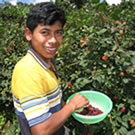 |
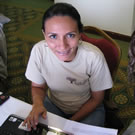 |
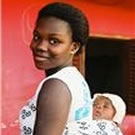 |
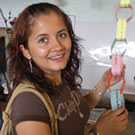 |
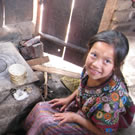 |
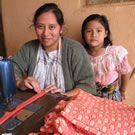 |
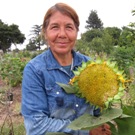 |
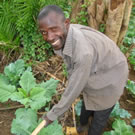 |
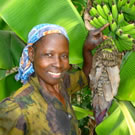 |
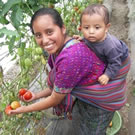 |
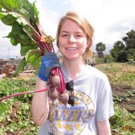 |
 |
Take photographs of the charts that you develop in the exercises.
Good luck at the workshop and enjoy yourself!
The homework to turn in will be:
1. A short summary of how the workshop went and how it was received by the community members.
2. A short paragraph on what worked well and also of things that you might do differently next time.
3. A few photographs of the workshop.
4. A photograph of a couple of the finished charts
Go to Magee’s Example Project Assignment Four to see what this could look like.
See you next week.